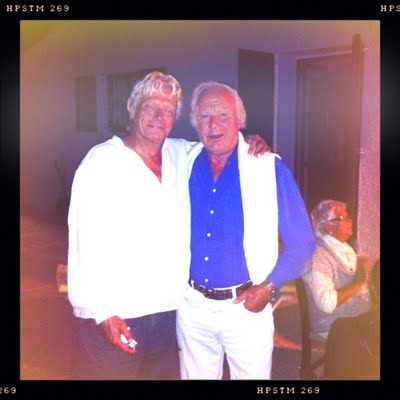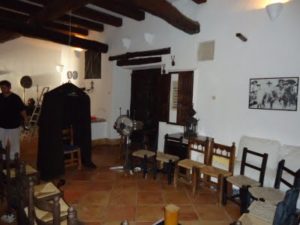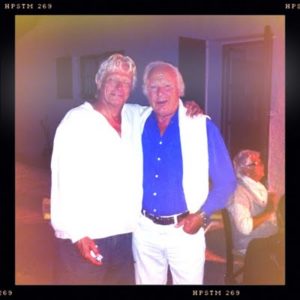Further Reading: Locating EVP Formation and Detecting False Positives
Abstract
Trans-etheric influences are seen to require physical processes to propagate in the physical. In practical terms, this means that such influences can be classified by the physical processes they require, and how they are seen to manifest. While actual physical principles employed in the formation of EVP have yet to be empirically determined, many elements of hypotheses proposing categorization and expected behaviors have been proposed and tested. From this knowledge base comes a clearer understanding of what is and is not EVP.
Introduction
Historically, Electronic Voice Phenomena (EVP) have been thought of as unexpected voices found in recording media. The primary technique for recording EVP has been with an audio recorder and the voice is thought to be formed of available audio energy (background noise).
Recent developments have made it practical to work with real-time, two-way EVP. With this development, an expanded definition is required. As one has not gained wide acceptance, the following should be considered a draft definition:
Electronic Voice Phenomena (EVP) are anomalous, intelligible speech produced in electronic devices. They may be heard as a real-time output but are more generally heard on review of a subsequent recording. No currently understood physical processes account for the existence of EVP.
EVP Formation
EVP can be collected under circumstances which preclude the possibility of such mundane sources as radio frequency contamination, unnoticed background conversations, contamination from previously recorded speech and mundane sounds mistaken as voice. People around the world have demonstrated this fact since before Friedrich Jürgenson made his famous EVP recordings fifty years ago June 12, 1959. The important point is that much is known about ordinary EVP formation which allows practitioners to recognize what is and is not phenomenal.
Transform EVP
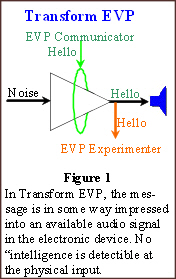
 As shown in Figure 1, the phenomenal utterance is formed in the recording device. Current theory is that noise is used for voice formation and the dominant physical process is thought to be the amplification of a weak telekinetic signal by the action of stochastic resonance on the broad-spectrum audio-frequency noise. The “frequencies” available in the sound stream at any moment will determine the richness of the resulting voice and no new audio energy is produced.
As shown in Figure 1, the phenomenal utterance is formed in the recording device. Current theory is that noise is used for voice formation and the dominant physical process is thought to be the amplification of a weak telekinetic signal by the action of stochastic resonance on the broad-spectrum audio-frequency noise. The “frequencies” available in the sound stream at any moment will determine the richness of the resulting voice and no new audio energy is produced.
There is no evidence that the psi processes involved in trans-etheric communication produce additional physical processes. Once the information is in the physical, it is completely subject to physical principles. Keep in mind that stochastic resonance was not documented as a process prior to 1981. The fact that a physical process needed to explain some aspect of EVP has not yet been defined does not mean that a paranormal solution must be used. It is important to this essay to note that the preponderance of evidence indicates the requirement of physical processes. There is no need to say that a phenomenal event somehow occurs or is caused by divine intervention.
The characteristics associated with traditionally formed (transform) EVP that are part of the theoretical model used by the ATransC include:
- EVP are not acoustical phenomena, meaning that they are formed in the recording mechanism, and can be collected with an acoustically isolated recorder.
- The voice is formed by transforming audio-frequency energy available in an electronic circuit into an approximation of human speech.
- EVP are energy limited, meaning that their formation is in short packets of a few words so that shorter packets tend to have greater volume, longer packets tend to have less volume and very long utterances are seen as several concatenated packets with brief pauses between each one.
- Any audio-frequency energy is apt to be transformed into voice as EVP.
- EVP formation occurs in analog circuits, and once digitized, tends to be stable.
- The utterances are formed by selecting available audio-frequency energy. Audio-frequency energy is not created for this purpose by the etheric communicator and may be in the form of relatively random noise, fragments of voice or synthesized voice.
Because of the many years of study by practitioners around the world, much is known about EVP recorded by traditional means. Small details of the characteristics listed here may be arguable but there is little doubt that this form of EVP occurs in audio recorders in a predictable way.
EVP formed by random selection
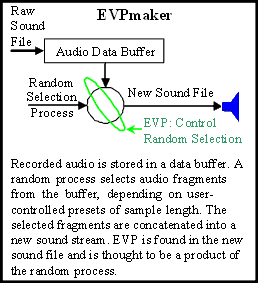 Stefan Bion has developed a computer program named EVPmaker which has been shown to produce EVP based on random selection of segments of a sound file. The input audio file may be recorded “live voice” but the program is able to use synthesized human voice fragments known as allophones and/or the smaller phonemes.
Stefan Bion has developed a computer program named EVPmaker which has been shown to produce EVP based on random selection of segments of a sound file. The input audio file may be recorded “live voice” but the program is able to use synthesized human voice fragments known as allophones and/or the smaller phonemes.
Precedence for psi influence of random processes has been established by the parapsychological community. For instance, the Princeton Engineering Anomalies Research (PEAR) Lab reported a small but significant effect in psi studies. Depending on presets made by the practitioner, the randomly selected segments of input file are typically too short to contain recognizable speech, especially when using synthesized speech. Once selected by the random process, the segments of sound are combined with others to produce the desired words. As such, EVP formation is thought to be controlled by control of the random process.
Audio output for EVPmaker is a staccato sound as if the system has developed a severe stutter. Recorded speech is considered “live voice” and is inherently suspect as a sound source for EVP formation; however, when using synthesized voice fragments, the input file can be controlled to minimize pre-existing recognizable words. As such, words in the output should be clearly random or they are phenomenal.
EVP formed by speech synthesis
 A recent development in the study of EVP is the introduction of speech synthesis technology. Bill Chappell has shown that it may be possible to produce meaningful utterances by detecting changes in the environment to control a speech synthesis process. The working assumption is that the communicating entity will change the environment to cause synthesis of the intended words. More research is needed, but the implication is that detection of presumably easily influenced chaotic processes such as room temperature and electrical charge can be used to initiate EVP formation by controlling a speech synthesis process. A second possibility is that the communicating entity is able to directly influence the speech synthesis circuit; however, more research must be conducted to determine this.
A recent development in the study of EVP is the introduction of speech synthesis technology. Bill Chappell has shown that it may be possible to produce meaningful utterances by detecting changes in the environment to control a speech synthesis process. The working assumption is that the communicating entity will change the environment to cause synthesis of the intended words. More research is needed, but the implication is that detection of presumably easily influenced chaotic processes such as room temperature and electrical charge can be used to initiate EVP formation by controlling a speech synthesis process. A second possibility is that the communicating entity is able to directly influence the speech synthesis circuit; however, more research must be conducted to determine this.
Chappell’s Paranormal Puck is programmed with words (speech mode), and a library of English-language phonemes (phoneme mode). Phonemes are the smallest segment of human speech, and when appropriately combined in an audio file, will produce meaningful speech.
An important point to consider in the analysis of environmentally controlled speech synthesis for EVP formation is that the only physical process necessary to explain observed results is a change in ambient energy detected by the device. The library of words or speech fragments is present in the designed capabilities of the technology.
Physical processes in EVP formation
Substantial research and field observation have shown that the processes involved in trans-etheric phenomena are probably knowable. Physical processes such as propagation of sound or light are measurable and their understanding can be applied to devices and other processes. In the same way, the processes governing subtle energy and the behavior of personalities after transition are knowable and able to be applied in technological solutions. A few of the assumptions used in this study of how EVP are formed are:
- EVP are formed via the influence of subtle energy (as intention) on physical processes according to knowable principles. With this assumption, the explanation for a phenomenal event that it “somehow” occurred cannot be used for research. The “somehow” should be quickly replaced by an established or modified theory. See: Physical Processes Involved in Trans-etheric Influences
- There is consistency in how subtle energy influences are able to affect physical processes. For instance, both visual forms such as images found in video feedback noise and EVP formed from background noise appear to depend on something like stochastic resonance. See: The Energy Profile of Transform EVP
- The influence of physical processes by subtle energy is energy limited and the most energy-efficient processes should be considered first. This also means the physical energy required for phenomena can be accounted for. See: The Energy Profile of Transform EVP
- Available physical processes can be initiated by an etheric influence to cause observable phenomena, but matter and energy are not seen to be created. An important implication of this assumption is that physical energy and objects may be transformed but they are not created to form phenomena. For instance, if sound is not present, it cannot be transformed into the words of EVP. The required sound will not be created but a physical process may be initiated which in turn causes sound for voice formation.
The observed characteristics of EVP suggest how they are (typically) formed, and by extension, how they (usually) are not formed. The average person can use this information to evaluate examples to help determine if they are mundane or paranormal. It also means that a deviation to the typical method of formation should be considered rare and the example should be held in reserve by practitioner and researchers alike until more data is available.
[Editor: In the proposed Energy Profile of Transform EVP study, it is speculated that stochastic amplification is the physical process involved in transform phenomena. That process depends on available physical energy–light or sound. Morphic fields are proposed as a possible etheric-physical process for the expression of intended order. The most speculative proposal, but one clearly supported in the above list, is that wave forms or images that already exist in the physical are apported into the transform process. The study associated with “The Energy Profile of Transform EVP” is intended to help quantify possible changes in energy profile for transform EVP formation. If one exists, it would tend to reinforce the apportation hypothesis.]
Sounds mistaken as EVP
Understanding common ways that ordinary sounds are mistaken as EVP provides a way of better understanding how the phenomenal voices are formed. As a reminder, the three types of EVP described above are well-established as trans-communication and there is little doubt of their authenticity as paranormal phenomena. The ways that ordinary events might be mistaken as phenomena are provided here as a way of helping practitioners avoid common “human nature” pitfalls.
Hearing what is expected
EVP practitioners listen very closely to sound files in an attempt to find meaningful sounds. This is because the audio signal normally thought of as just background noise is considered a likely place to find a paranormal message. However, audio files thought to be needed for voice formation are usually very noisy and meaning is potentially everywhere. It is common for a distant but ordinary conversation to be detected by a recorder and then be reported as phenomenal. When a practitioner is expecting a meaningful sound, the next sound is sometimes given that meaning no matter what intelligence the sound actually carries.
Typical sources of sound mistaken as EVP include:
- Ordinary variations in background sound mistaken as voice: For instance, a burst of static is sometimes heard as an angry voice.
- Stray radio signals mistaken as EVP: Hand-held, battery-powered recorders are excellent antenna for radio reception and the electronics are capable of making stray AM signals understandable.
- “Morphed” foreign-language sound source: Naturally occurring foreign-language words are sometimes reported as having been “morphed” into EVP but then are recognized by a person who speaks the foreign language as not being EVP at all.
- Reversing a soundtrack: Some words sound like other words when heard in the reverse.
- Ordinary sound changed with an audio editor to simulate EVP: Changing the tempo of a sound file can change its intended meaning. Since voices of EVP are usually formed out of the background noise, filtering the noise can sometimes change how the words are heard. Excessive amplification can make detected radio audible.
Ways EVP might be misreported
There is some evidence that a sound file might be altered while it is in an analog form, but sound files are thought to be stable once they have been digitized. As such, many people can hear the same digitized sound file and should hear the same sounds. If there is an anomalous utterance in the sound file, then it will be the same each time. This is an important characteristic of EVP if online listening tests are to be trusted to produce meaningful data.
With that said, it is common to see a doubtful EVP example shared on the Internet with a surprising number of people saying they hear it as the practitioner reported. In subsequent tests, it is possible that even the person who reported the example will not be able to understand the utterance. Assuming the practitioner and listeners did hear the example as reported even though the words were not actually present, what would explain the confusion?
The most common problems include:
- Suggesting what should be heard: Especially when the example is of marginal quality, the listener is easily guided to hear what is expected by how the example is reported even though the words may not be present.
- Fabricating a “likely story”: The practitioner has asked a question and expects the next sound to contain the answer. Whatever the next sound “sounds like” is taken as part of the answer even though it may not make logical sense. To make it sound correct, the practitioner applies meaning to subsequent sounds to tell a story that provides a plausible answer to the question.
- Setting listener expectation in “real-time” dialogue: Two-way conversations via EVP are very difficult, and while shown to be possible, the process can also be misleading. It is reasonable for the practitioner to ask the entity to repeat a word by saying something like, “Did I hear you say ‘Tom?’” However, in doing so, the listener is preconditioned to hear “Tom,” even though the word may not be present.
- Selectively relating utterances to questions: The usual recommendation is that the words of an EVP just before or just after the practitioner’s question can appropriately be applied to the question. As such, asking a question and selecting a word out of a string of possible utterances would be considered selective reporting.

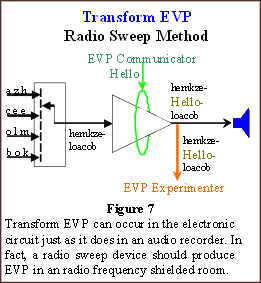
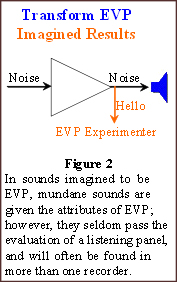
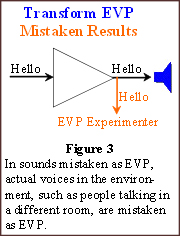

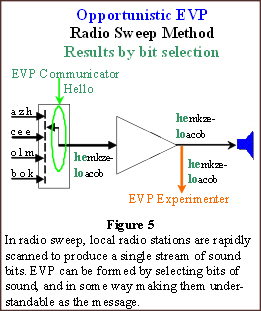
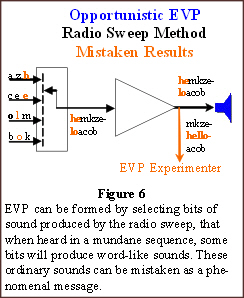
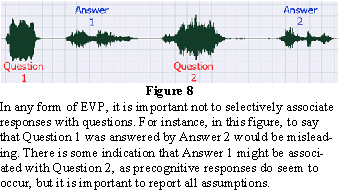 In transform EVP, the utterance typically occurs before the next question or comment. In some instances, convincing evidence has been reported suggesting that some utterances precede the question, as if anticipating it. (An alternative explanation to precognition is that the experimenter anticipates the question by mentally composing it before speaking, and that mental processing is detected and responded to.)
In transform EVP, the utterance typically occurs before the next question or comment. In some instances, convincing evidence has been reported suggesting that some utterances precede the question, as if anticipating it. (An alternative explanation to precognition is that the experimenter anticipates the question by mentally composing it before speaking, and that mental processing is detected and responded to.)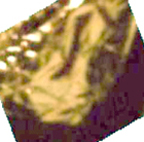
 What I am going to tell you happened in Brittany on the 9th of July 2004, when we were on holiday. It was after dinner and I had just put a piece of aluminum foil on a plate of cheese to cover it. I know … It’s very prosaic and my mind was far from any experiment but this is what happened.
What I am going to tell you happened in Brittany on the 9th of July 2004, when we were on holiday. It was after dinner and I had just put a piece of aluminum foil on a plate of cheese to cover it. I know … It’s very prosaic and my mind was far from any experiment but this is what happened.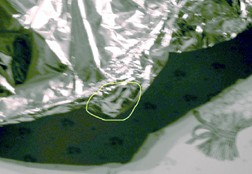
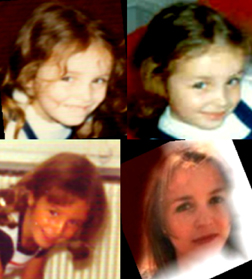
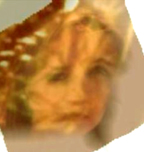
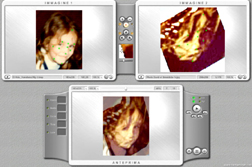
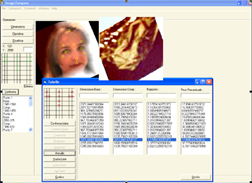
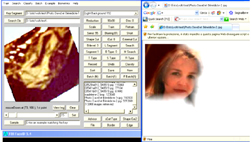
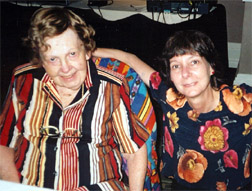


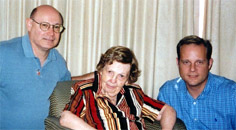
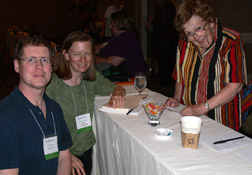
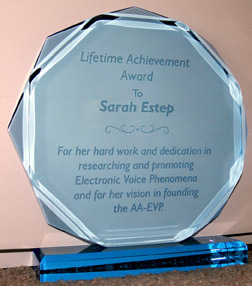 presented a brief introduction about her experience with EVP and then some of her best EVP examples were played, ending with a one minute EVP containing music thought to have been originated by Ludwig Beethoven.
presented a brief introduction about her experience with EVP and then some of her best EVP examples were played, ending with a one minute EVP containing music thought to have been originated by Ludwig Beethoven.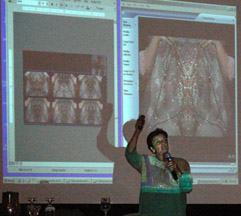


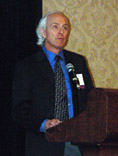
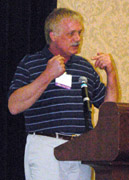
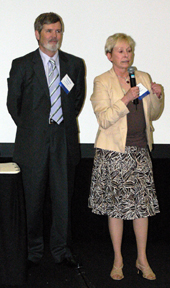

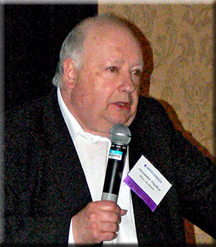

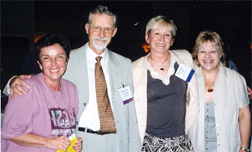
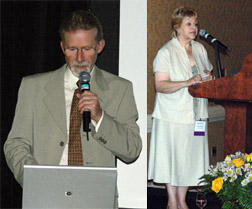
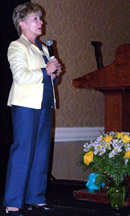
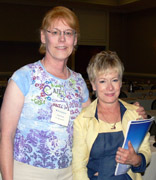
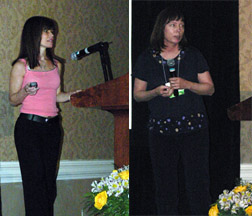



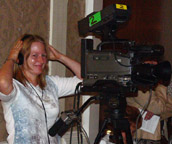

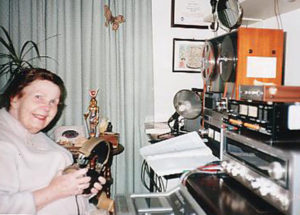

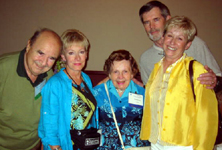
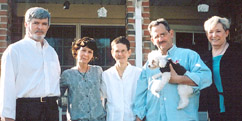

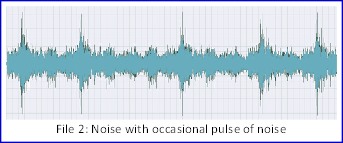 Website visitors have used the contact tool to announce that they are receiving astoundingly long and important EVP, which on close examination, have proven to only contain noise. Yet, others have provided excellent, clearly heard examples. So what is the difference? What leads one person to hear messages where there is only noise while others do not?
Website visitors have used the contact tool to announce that they are receiving astoundingly long and important EVP, which on close examination, have proven to only contain noise. Yet, others have provided excellent, clearly heard examples. So what is the difference? What leads one person to hear messages where there is only noise while others do not?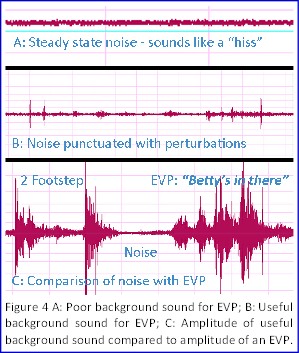

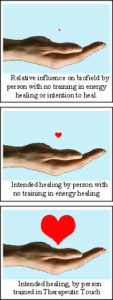 The findings of this study from a reputable institution with a proven research record in investigating cellular reactions would be accepted without question if the cells had been irradiated by, say, infrared or red light, as absorption of such frequencies is known to increase the rate of cell metabolism and consequent cell proliferation. The study would be taken as providing further confirmation of many earlier laboratory studies and clinical trials on wound healing to that effect.
The findings of this study from a reputable institution with a proven research record in investigating cellular reactions would be accepted without question if the cells had been irradiated by, say, infrared or red light, as absorption of such frequencies is known to increase the rate of cell metabolism and consequent cell proliferation. The study would be taken as providing further confirmation of many earlier laboratory studies and clinical trials on wound healing to that effect.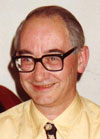 Robert Charman is a retired physical therapy lecturer whose specialities were neuro-rehabilitation and biophysics. The former gave him an enduring interest in the mind/brain problem and the latter an interest in the role of the currents and fields generated by cells and tissues. He was founder/chair of the Association of Chartered Physiotherapists in Energy Medicine (ACPEM), and is Chair of the Confederation of Healing Organisations, both UK organizations. He was editor of Complementary Therapies for Physical Therapists (2000); has published a review of EEG and fMRI evidence for direct brainmind-to-brainmind communication (J.Soc.Psych.Res download www.spr.ac.uk), and articles reviewing evidence for telepathy, remote viewing, psychokinesis, healing intention on living systems, and the mind/brain relationship. On the latter his position is that correlation should not be confused with explanation.
Robert Charman is a retired physical therapy lecturer whose specialities were neuro-rehabilitation and biophysics. The former gave him an enduring interest in the mind/brain problem and the latter an interest in the role of the currents and fields generated by cells and tissues. He was founder/chair of the Association of Chartered Physiotherapists in Energy Medicine (ACPEM), and is Chair of the Confederation of Healing Organisations, both UK organizations. He was editor of Complementary Therapies for Physical Therapists (2000); has published a review of EEG and fMRI evidence for direct brainmind-to-brainmind communication (J.Soc.Psych.Res download www.spr.ac.uk), and articles reviewing evidence for telepathy, remote viewing, psychokinesis, healing intention on living systems, and the mind/brain relationship. On the latter his position is that correlation should not be confused with explanation.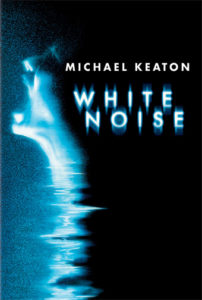
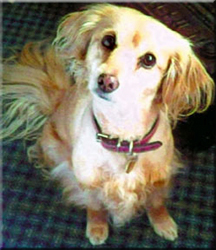
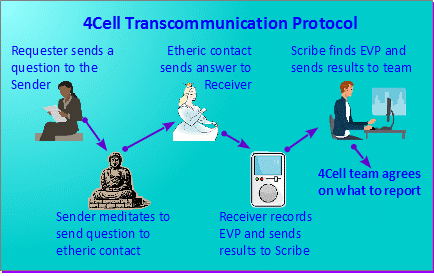

 In effect, this is a worldwide group recording session. It is our belief that the combine intention to contact loved ones on this day produces more energy for communication than what can be managed individually. Even if we are not all recording at the same moment, we are all turning our attention to the same objective during the same day. This attention helps gather the energy necessary for communication, and that helps all of us. Remember, our time and distance are irrelevant to our etheric loved ones in the etheric.
In effect, this is a worldwide group recording session. It is our belief that the combine intention to contact loved ones on this day produces more energy for communication than what can be managed individually. Even if we are not all recording at the same moment, we are all turning our attention to the same objective during the same day. This attention helps gather the energy necessary for communication, and that helps all of us. Remember, our time and distance are irrelevant to our etheric loved ones in the etheric.

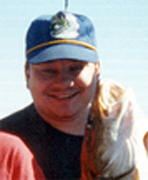
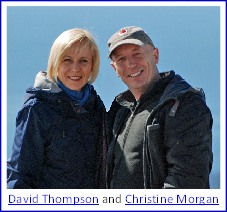
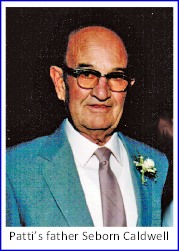 David told us where to sit; I was told that this is to balance the energy of the circle. We waited while the sitters were searched by two people that I knew did not know David. David put on his sweater, it was buttoned up and then zip tied closed. After he sat in his chair in the cabinet he was bound, secured with zip ties and gagged. The lights were turned off and the door was locked. A music CD was played and we were instructed to sing to the music until Christine instructed us to stop.
David told us where to sit; I was told that this is to balance the energy of the circle. We waited while the sitters were searched by two people that I knew did not know David. David put on his sweater, it was buttoned up and then zip tied closed. After he sat in his chair in the cabinet he was bound, secured with zip ties and gagged. The lights were turned off and the door was locked. A music CD was played and we were instructed to sing to the music until Christine instructed us to stop. We next heard a male voice coming out of the cabinet who asked for Patti. I knew immediately that it was my father. I told him to follow my voice. He took my head in his hands and kissed my cheek and put his cheek next to mine. I could feel his whiskers! My father had a very heavy beard, and if he went out at night, he would shave again. He thanked me for caring for him and told me how much he loved me. He also told me how proud he was of me and said that he is always near me and will try to help in a circle that I sit in. Again, he told me he loved me. I told him I loved him and what a great father he was. I then heard him back up and then heard the slurp of returning ectoplasm. I was crying with happy tears. His appearance took me back to when I was a small child sitting and rocking on his lap before bedtime. I again felt that unconditional love that only a parent can give. I didn’t want it to ever end.
We next heard a male voice coming out of the cabinet who asked for Patti. I knew immediately that it was my father. I told him to follow my voice. He took my head in his hands and kissed my cheek and put his cheek next to mine. I could feel his whiskers! My father had a very heavy beard, and if he went out at night, he would shave again. He thanked me for caring for him and told me how much he loved me. He also told me how proud he was of me and said that he is always near me and will try to help in a circle that I sit in. Again, he told me he loved me. I told him I loved him and what a great father he was. I then heard him back up and then heard the slurp of returning ectoplasm. I was crying with happy tears. His appearance took me back to when I was a small child sitting and rocking on his lap before bedtime. I again felt that unconditional love that only a parent can give. I didn’t want it to ever end.